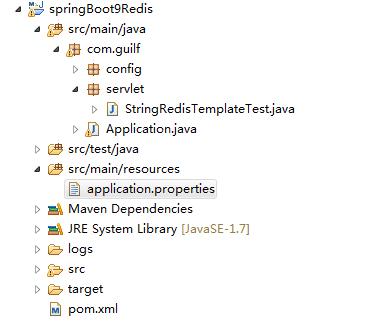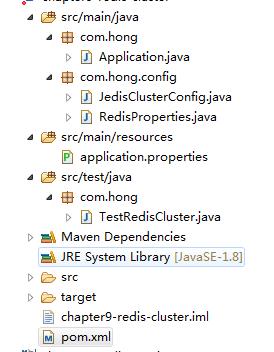spring boot redis(连接,增删改查,集群,和session一起使用)
Posted 蜗牛的坚持
tags:
篇首语:本文由小常识网(cha138.com)小编为大家整理,主要介绍了spring boot redis(连接,增删改查,集群,和session一起使用)相关的知识,希望对你有一定的参考价值。
1.建立连接

1.1 pom.xml
<!-- redis 相关支持 -->
<dependency>
<groupId>org.springframework.boot</groupId>
<artifactId>spring-boot-starter-redis</artifactId>
<version>1.3.2.RELEASE</version>
</dependency>
1.2 application.properties
#Servlet端口号 server.port=8088 # REDIS (RedisProperties) # Redis数据库索引(默认为0) spring.redis.database=0 # Redis服务器地址 spring.redis.host=192.168.88.134 # Redis服务器连接端口 spring.redis.port=6379 # Redis服务器连接密码(默认为空) spring.redis.password=123456 # 连接池最大连接数(使用负值表示没有限制) spring.redis.pool.max-active=8 # 连接池最大阻塞等待时间(使用负值表示没有限制) spring.redis.pool.max-wait=-1 # 连接池中的最大空闲连接 spring.redis.pool.max-idle=8 # 连接池中的最小空闲连接 spring.redis.pool.min-idle=0 # 连接超时时间(毫秒) spring.redis.timeout=0
1.3 StringRedisTemplateTest.java
package com.guilf.servlet;
import org.junit.Test;
import org.junit.runner.RunWith;
import org.slf4j.Logger;
import org.slf4j.LoggerFactory;
import org.springframework.beans.factory.annotation.Autowired;
import org.springframework.boot.test.context.SpringBootTest;
import org.springframework.data.redis.core.StringRedisTemplate;
import org.springframework.test.context.junit4.SpringJUnit4ClassRunner;
/**
* Created by hong on 2017/5/2.
*/
@RunWith(SpringJUnit4ClassRunner.class)
@SpringBootTest
public class StringRedisTemplateTest {
private final Logger logger = LoggerFactory.getLogger(this.getClass());
@Autowired
private StringRedisTemplate stringRedisTemplate;
@Test
public void test(){
stringRedisTemplate.opsForValue().set("aaa","aaa111");
logger.info(stringRedisTemplate.opsForValue().get("aaa"));
}
}
1.4 运行测试

2,对增删改查 redis的操作
package com.hong.service.impl;
import com.hong.domain.City;
import com.hong.mapper.CityMapper;
import com.hong.service.CityService;
import org.slf4j.Logger;
import org.slf4j.LoggerFactory;
import org.springframework.beans.factory.annotation.Autowired;
import org.springframework.data.redis.core.RedisTemplate;
import org.springframework.data.redis.core.ValueOperations;
import org.springframework.stereotype.Service;
import java.util.concurrent.TimeUnit;
/**
*
*/
@Service
public class CityServiceImpl implements CityService {
private final Logger logger = LoggerFactory.getLogger(this.getClass());
@Autowired
private CityMapper cityMapper;
@Autowired
private RedisTemplate redisTemplate;
private final String KEY_PREFIX = "city_";
/**
* 获取城市逻辑:
* 如果缓存存在,从缓存中获取城市信息
* 如果缓存不存在,从 DB 中获取城市信息,然后插入缓存
*/
@Override
public City findOneCity(Integer id) {
ValueOperations<String, City> valueOperations = redisTemplate.opsForValue();
//缓存存在
String key = KEY_PREFIX + id;
boolean hasKey = redisTemplate.hasKey(key);
if (hasKey) {
City city = valueOperations.get(key);
logger.info("CityServiceImpl.findOneCity() : 从缓存中获取了城市 >> " + city.toString());
return city;
}
//从mysql 数据库中获取数据
City city = cityMapper.selectByPrimaryKey(id);
//存入缓存中.
valueOperations.set(key, city, 10, TimeUnit.SECONDS);
logger.info("CityServiceImpl.findOneCity() : 城市加入了缓存 >> " + city.toString());
return city;
}
@Override
public int saveCity(City city) {
return cityMapper.insert(city);
}
@Override
public int modifyCity(City city) {
//更新DB中的数据
int count = cityMapper.updateByPrimaryKey(city);
//如果缓存中存在,移除。
String key = KEY_PREFIX + city.getId();
boolean hasKey = redisTemplate.hasKey(key);
if (hasKey) {
redisTemplate.delete(key);
logger.info("CityServiceImpl.modifyCity 从缓存中移除了城市" + city.toString());
}
return count;
}
@Override
public int deleteCity(Integer id) {
//删除DB中的数据
int count = cityMapper.deleteByPrimaryKey(id);
//如果缓存中存在,移除。
String key = KEY_PREFIX + id;
boolean hasKey = redisTemplate.hasKey(key);
if (hasKey) {
redisTemplate.delete(key);
logger.info("CityServiceImpl.modifyCity 从缓存中移除了城市 ID:" + id);
}
return count;
}
}
3.如果是集群

pom.xml
<!-- redis 相关支持, 默认包含了Jedis依赖 -->
<dependency>
<groupId>org.springframework.boot</groupId>
<artifactId>spring-boot-starter-redis</artifactId>
<version>1.3.2.RELEASE</version>
</dependency>
application.properties
#redis cluster spring.redis.cluster.nodes=127.0.0.1:7000,127.0.0.1:7001,127.0.0.1:7002 spring.redis.cluster.commandTimeout=5000
RedisProperties.java
package com.guilf.config;
import org.springframework.boot.context.properties.ConfigurationProperties;
import org.springframework.stereotype.Component;
/**
*
*/
@Component
@ConfigurationProperties(prefix = "spring.redis.cluster")
public class RedisProperties {
private String nodes;
private Integer commandTimeout;
public String getNodes() {
return nodes;
}
public void setNodes(String nodes) {
this.nodes = nodes;
}
public Integer getCommandTimeout() {
return commandTimeout;
}
public void setCommandTimeout(Integer commandTimeout) {
this.commandTimeout = commandTimeout;
}
}
JedisClusterConfig.java
package com.guilf.config;
import org.springframework.beans.factory.annotation.Autowired;
import org.springframework.boot.autoconfigure.condition.ConditionalOnClass;
import org.springframework.boot.context.properties.EnableConfigurationProperties;
import org.springframework.context.annotation.Bean;
import org.springframework.context.annotation.Configuration;
import org.springframework.core.env.MapPropertySource;
import org.springframework.data.redis.connection.RedisClusterConfiguration;
import org.springframework.data.redis.connection.jedis.JedisConnectionFactory;
import org.springframework.data.redis.core.RedisTemplate;
import org.springframework.data.redis.serializer.StringRedisSerializer;
import redis.clients.jedis.HostAndPort;
import redis.clients.jedis.JedisCluster;
import java.util.HashMap;
import java.util.HashSet;
import java.util.Map;
import java.util.Set;
/**
*
*/
@Configuration
@ConditionalOnClass({JedisCluster.class})
@EnableConfigurationProperties(RedisProperties.class)
public class JedisClusterConfig {
@Autowired
private RedisProperties redisProperties;
@Bean
public JedisCluster jedisClusterFactory() {
String[] serverArray = redisProperties.getNodes().split(",");
Set<HostAndPort> nodes = new HashSet<>();
for (String ipPort: serverArray) {
String[] ipPortPair = ipPort.split(":");
nodes.add(new HostAndPort(ipPortPair[0].trim(),Integer.valueOf(ipPortPair[1].trim())));
}
return new JedisCluster(nodes, redisProperties.getCommandTimeout());
}
@Bean
public RedisTemplate redisTemplateFactory(){
RedisTemplate redisTemplate =new RedisTemplate();
redisTemplate.setConnectionFactory(jedisConnectionFactory());
//指定具体序列化方式 不过这种方式不是很好,一个系统中可能对应值的类型不一样,如果全部使用StringRedisSerializer 序列化
//会照成其他类型报错,所以还是推荐使用第一种,直接指定泛型的类型,spring 会根据指定类型序列化。
//redisTemplate.setKeySerializer( new StringRedisSerializer());
//redisTemplate.setValueSerializer(new StringRedisSerializer());
//redisTemplate.setHashKeySerializer(new StringRedisSerializer());
//redisTemplate.setHashValueSerializer(new StringRedisSerializer());
return redisTemplate;
}
/**
* redisCluster配置
* @return
*/
@Bean
public RedisClusterConfiguration redisClusterConfiguration() {
Map<String, Object> source = new HashMap<String, Object>();
source.put("spring.redis.cluster.nodes", redisProperties.getNodes());
source.put("spring.redis.cluster.timeout", redisProperties.getCommandTimeout());
return new RedisClusterConfiguration(new MapPropertySource("RedisClusterConfiguration", source));
}
/**
* 其实在JedisConnectionFactory的afterPropertiesSet()方法 中
* if(cluster !=null) this.cluster =createCluster();
* 也就是当
* spring.redis.cluster.nodes 配置好的情况下,就可以实例化 JedisCluster.
* 也就是说,我们使用JedisCluster 的方式只需要在application.properties 配置文件中
*
* #redis cluster
* spring.redis.cluster.nodes=127.0.0.1:7000,127.0.0.1:7001,127.0.0.1:7002
*
* RedisTemplate.afterPropertiesSet() 中查看到最终方法中使用了JedisCluster 对象。
* 也就是说 redisTemplate依赖jedis ,内部操作的就是jedis,同理内部也操作jedisCluster.
*
*
* @return
*/
@Bean
public JedisConnectionFactory jedisConnectionFactory() {
return new JedisConnectionFactory(redisClusterConfiguration());
}
}
TestRedisCluster.java
package com.guilf;
import org.junit.Assert;
import org.junit.Test;
import org.junit.runner.RunWith;
import org.slf4j.Logger;
import org.slf4j.LoggerFactory;
import org.springframework.beans.factory.annotation.Autowired;
import org.springframework.boot.test.context.SpringBootTest;
import org.springframework.data.redis.core.RedisTemplate;
import org.springframework.test.context.junit4.SpringJUnit4ClassRunner;
import org.springframework.test.context.web.WebAppConfiguration;
import redis.clients.jedis.JedisCluster;
/**
*
*/
@RunWith(SpringJUnit4ClassRunner.class)
@SpringBootTest(classes ={Application.class})
@WebAppConfiguration
public class TestRedisCluster {
private final Logger logger = LoggerFactory.getLogger(this.getClass());
@Autowired
private JedisCluster jedisCluster;
/**
* 注: 我们在使用RedisTemplate 时,在不指定<K, V> 具体值时,
* spring默认采用defaultSerializer = new JdkSerializationRedisSerializer();来对key,value进行序列化操作,
* 所以这时候redis 的可以 就会出来一堆的\\xac\\xed\\x00\\x05t\\x00\\tb 这种东西;
*
* 所以我们可以选择两种处理方法:
* 1.直接使用RedisTemplate<String,String> 指定。
* 2.
*
*/
@Autowired
private RedisTemplate<String,String> redisTemplate;
@Test
public void test(){
jedisCluster.set("test_jedis_cluster","123456");
Assert.assertEquals("123456",jedisCluster.get("test_jedis_cluster"));
String value = jedisCluster.get("test_jedis_cluster");
logger.info(value);
redisTemplate.opsForValue().set("kkk","kkk");
redisTemplate.opsForValue().set("k2","v2");
logger.info(redisTemplate.opsForValue().get("kkk"));
logger.info(redisTemplate.opsForValue().get("test_jedis_cluster"));
}
}
4.与session一起用

pom.xml
<!-- redis 相关支持 -->
<dependency>
<groupId>org.springframework.boot</groupId>
<artifactId>spring-boot-starter-redis</artifactId>
<version>1.3.2.RELEASE</version>
</dependency>
<!-- Spring Redis Session相关依赖 -->
<dependency>
<groupId>org.springframework.session</groupId>
<artifactId>spring-session-data-redis</artifactId>
</dependency>
application.properties
#Servlet端口号 server.port=8088 # REDIS (RedisProperties) # Redis数据库索引(默认为0) spring.redis.database=0 # Redis服务器地址 #spring.redis.host-name=192.168.88.134 spring.redis.host=192.168.88.134 # Redis服务器连接端口 spring.redis.port=6379 # Redis服务器连接密码(默认为空) spring.redis.password=123456 # 连接池最大连接数(使用负值表示没有限制) spring.redis.pool.max-active=8 # 连接池最大阻塞等待时间(使用负值表示没有限制) spring.redis.pool.max-wait=-1 # 连接池中的最大空闲连接 spring.redis.pool.max-idle=8 # 连接池中的最小空闲连接 spring.redis.pool.min-idle=0 # 连接超时时间(毫秒) spring.redis.timeout=0 #若想知道SpringBoot为我们做了哪些自动配置,可以在application.properties里添加参?数 #运行Spring Boot 项目时,就会看到Positive matches 列表; # 包括本例使用redis session 相关配置. #debug=true
RedisSessionConfig.java
package com.guilf;
import org.springframework.context.annotation.Bean;
import org.springframework.context.annotation.Configuration;
import org.springframework.data.redis.connection.jedis.JedisConnectionFactory;
import org.springframework.session.data.redis.config.ConfigureRedisAction;
import org.springframework.session.data.redis.config.annotation.web.http.EnableRedisHttpSession;
/**
*
*/
//@Configuration
/**
* 通过加上@EnableRedisHttpSession注解,开启redis集中式session管理,所有的session都存放到了redis中
* maxInactiveIntervalInSeconds 配置session 失效时间
* **/
//@EnableRedisHttpSession(maxInactiveIntervalInSeconds = 86400 * 30)
@Configuration
@EnableRedisHttpSession(maxInactiveIntervalInSeconds = 86400 * 30)
public class RedisSessionConfig {
/**
* 配置实用Jedis 连接池的方式 连接Redis服务(默认就是使用的這种方式,所以可以不配)
* @return
*/
// @Bean
// public JedisConnectionFactory connectionFactory(){
// return new JedisConnectionFactory();
// }
}
SessionController.java
package com.guilf.mvc;
import org.springframework.web.bind.annotation.RequestMapping;
import org.springframework.web.bind.annotation.RestController;
import javax.servlet.http.HttpSession;
import java.util.UUID;
/**
*
*/
@RestController
public class SessionController {
@RequestMapping("/helloSession")
public String helloSession(HttpSession session) {
UUID uuid = (UUID) session.getAttribute("uuid");
if (uuid == null) {
uuid =UUID.randomUUID();
}
session.setAttribute("uuid",uuid);
return session.getId();
}
}
启动

以上是关于spring boot redis(连接,增删改查,集群,和session一起使用)的主要内容,如果未能解决你的问题,请参考以下文章